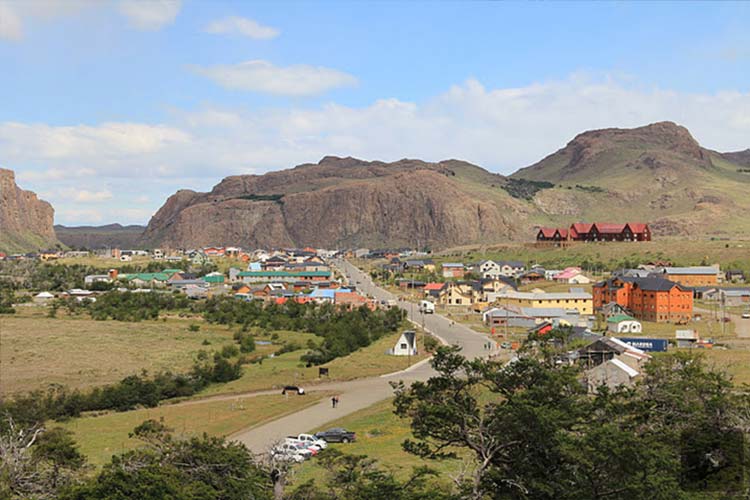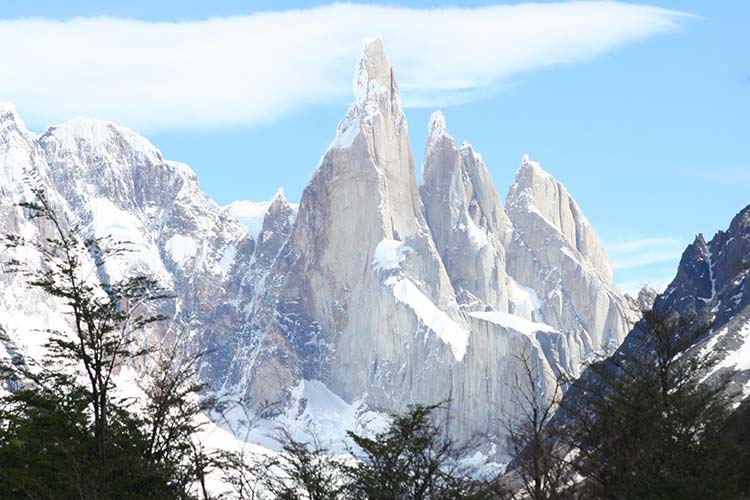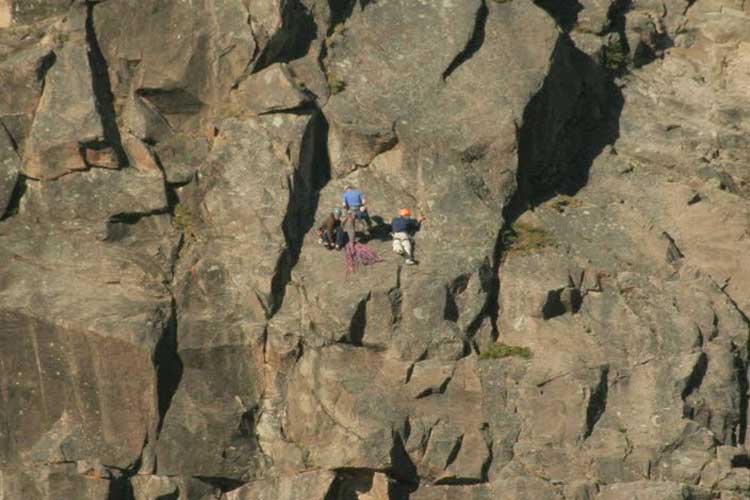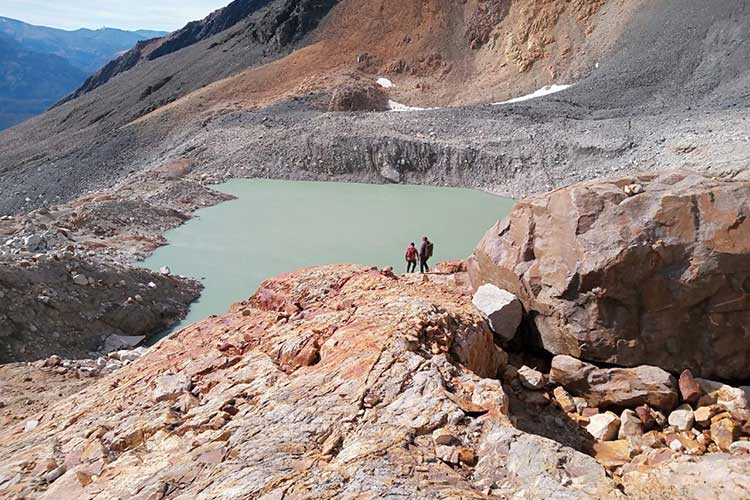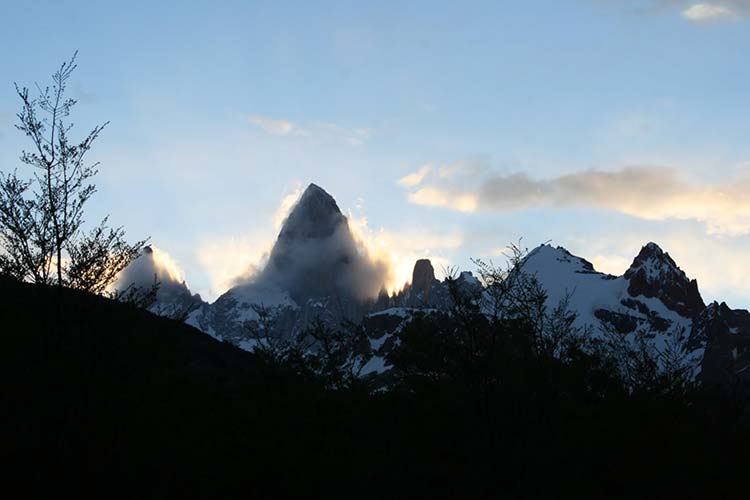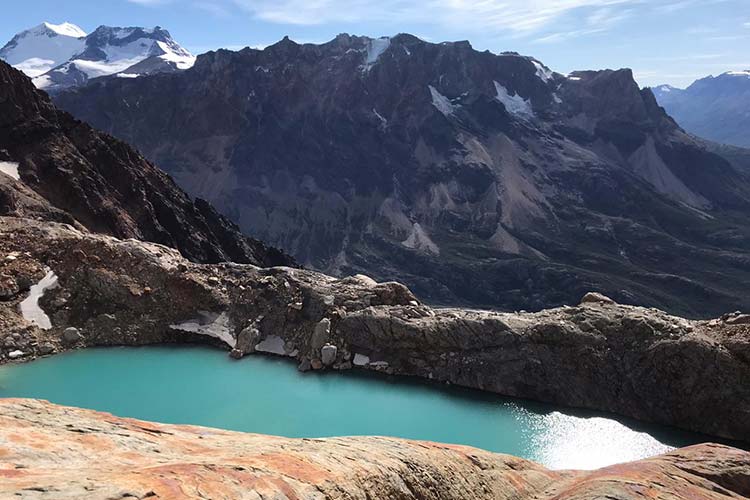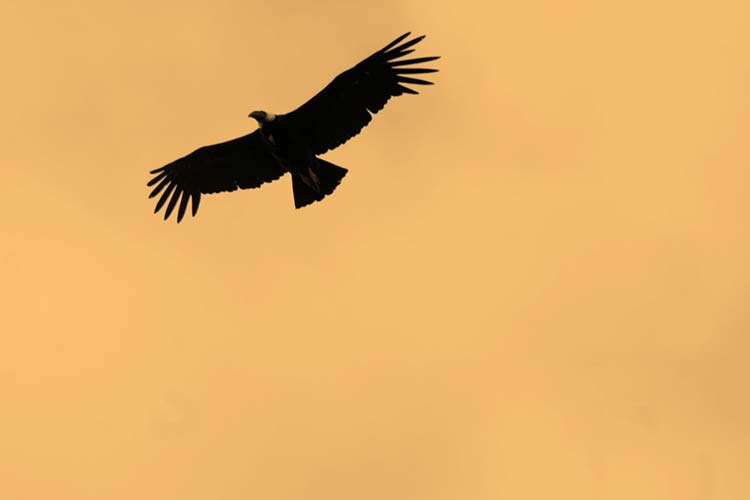El Chaltén
Surrounded by natural settings of unique beauty, declared the "National Capital of Trekking", whoever visits El Chaltén will fall in love with it.
A beautiful corner of Patagonia
El Chaltén is a small tourist village located in the extreme north of Los Glaciares National Park, in the heart of the southern Patagonian mountain range, at the foot of the mythical Mount Fitz Roy, rich in flora and fauna, in the history of its pioneers and climbers. of all the world. Behind the colossal granite walls that dominate the landscape is the famous Southern Patagonian Ice Field, the most important continental ice mass on our planet after Antarctica, from which the glaciers that feed the great lakes in the area descend.
To get to this paradise of pure nature, you arrive at the next town of El Calafate, by plane or bus, and from there you travel 215 km of the Patagonian steppe along the recently paved route that surrounds the Argentino and Viedma lakes.
To get to this paradise of pure nature, you arrive at the next town of El Calafate, by plane or bus, and from there you travel 215 km of the Patagonian steppe along the recently paved route that surrounds the Argentino and Viedma lakes.
Services. The offer of services and products in El Chaltén is varied and continuously growing. To stay there are many options, the most popular are hostels and cabins. To eat, visitors will find restaurants, pizzerias and bars. Visitors should keep in mind that due to its isolated geographical situation. The town has internet and cellular telephony
The activities
El Chaltén and its surroundings offer a privileged setting with many alternatives for practicing outdoor activities and mountain sports, so it invites us to enjoy the boldest and most unforgettable adventure.
Various itineraries can be made: from visiting panoramic points a few minutes' walk and with a minimum degree of difficulty, to expeditions of several days or climbing the large vertical walls reserved only for the best mountaineers. The most sought-after activities in the area are: trekking, mountaineering, camping, horseback riding, excursions and others such as photography, climbing courses, bird watching, fishing or visiting the legendary Estancias of Santa Cruz. All of them accompanied by the beauties that our Patagonia offers.
Various itineraries can be made: from visiting panoramic points a few minutes' walk and with a minimum degree of difficulty, to expeditions of several days or climbing the large vertical walls reserved only for the best mountaineers. The most sought-after activities in the area are: trekking, mountaineering, camping, horseback riding, excursions and others such as photography, climbing courses, bird watching, fishing or visiting the legendary Estancias of Santa Cruz. All of them accompanied by the beauties that our Patagonia offers.
For all this, El Chaltén has been declared National Trekking Capital in Argentina . Among the places of great natural beauty that surround El Chaltén stands out the Lago del Desierto, a paradise of ancient forests and glaciers just 37 km from the town and where sport fishing is possible, camping or trekking, among other activities.
Los Glaciares National Park
Los Glaciares National Park is located in the region known as the Southern Andes of the Argentine territory, southwest of the province of Santa Cruz on the border with Chile. It was created in 1937 to protect a vast region dominated by glaciers, bordered by native subantarctic forest and a significant number of endemic species of plants and animals.
This unique natural wonder in the world has been declared "World Heritage" by UNESCO in 1981.
The national park comprises a setting of mountains, lakes and forests, including a vast portion of the Andes Mountains practically covered with ice and snow to the west and the arid Patagonian steppe to the east. Its name is due to the presence of numerous glaciers that originate in the great Southern Patagonian Ice Field - the largest ice sheet in the southern hemisphere after Antarctica - which occupies almost half of the Park. Also known as Southern Patagonian Ice, it feeds 47 large glaciers, of which 13 descend into the Atlantic basin. In addition, there are more than 200 smaller glaciers, independent of the Patagonian Ice Field.
Although the great ice masses are usually found on our planet at more than 2,500 meters above sea level, the glaciers in the province of Santa Cruz originate at only 1,500 meters above sea level and descend to 200 meters above sea level, allowing access and unique viewing in the world. The melting of this immense water system originates the two great lakes Argentino and Viedma, which discharge their waters into the Atlantic Ocean, crossing the entire province through the Santa Cruz River.
In the southern part of the Park, there is the most famous of all glaciers: the Perito Moreno Glacier. It owes its fame to its continuous movement, which produces a cyclical phenomenon of forward and reverse with spectacular detachments from its ice front. The closest town to the glacier is El Calafate, epicenter of all activities and services.
Monte Fitz Roy: At the northern end of the Park are the highest peaks and the greatest diversity of granite forms in the mountain range, which together with forests, glaciers and lakes, make up one of the most extraordinary sites in our country. The maximum height is Mount Fitz Roy or Chaltén (3405m) supported by Cerro Torre (3102m). In this scenario is the small town of El Chaltén.
This unique natural wonder in the world has been declared "World Heritage" by UNESCO in 1981.
The national park comprises a setting of mountains, lakes and forests, including a vast portion of the Andes Mountains practically covered with ice and snow to the west and the arid Patagonian steppe to the east. Its name is due to the presence of numerous glaciers that originate in the great Southern Patagonian Ice Field - the largest ice sheet in the southern hemisphere after Antarctica - which occupies almost half of the Park. Also known as Southern Patagonian Ice, it feeds 47 large glaciers, of which 13 descend into the Atlantic basin. In addition, there are more than 200 smaller glaciers, independent of the Patagonian Ice Field.
Although the great ice masses are usually found on our planet at more than 2,500 meters above sea level, the glaciers in the province of Santa Cruz originate at only 1,500 meters above sea level and descend to 200 meters above sea level, allowing access and unique viewing in the world. The melting of this immense water system originates the two great lakes Argentino and Viedma, which discharge their waters into the Atlantic Ocean, crossing the entire province through the Santa Cruz River.
In the southern part of the Park, there is the most famous of all glaciers: the Perito Moreno Glacier. It owes its fame to its continuous movement, which produces a cyclical phenomenon of forward and reverse with spectacular detachments from its ice front. The closest town to the glacier is El Calafate, epicenter of all activities and services.
Monte Fitz Roy: At the northern end of the Park are the highest peaks and the greatest diversity of granite forms in the mountain range, which together with forests, glaciers and lakes, make up one of the most extraordinary sites in our country. The maximum height is Mount Fitz Roy or Chaltén (3405m) supported by Cerro Torre (3102m). In this scenario is the small town of El Chaltén.
The weather
In general, the climate in El Chaltén can be summed up in one word: "unpredictable". The unforgiving wind, known icon of Patagonia, is an inescapable presence, especially between October and March ... although it can be found in any month of the year. Sharp changes in temperature and the sudden appearance of dense cloud cover, heavy rain and even snow on the same day that dawned sunny and with no clouds on the horizon (and the reverse situation) is a feature that can take visitors by surprise when going out to walk, so you should always take warm clothes and raincoats with you even if the day seems optimal.
Also, since in these southern latitudes the solar radiation is considerably accentuated (even on cloudy days), it is advisable to always use sun protection for the skin.
As one approaches the valleys west to the mass of the Southern Icefield and gains in altitude, conditions are increasingly humid and cold. On cold days it is possible that snow falls in the base camps while in the town it is only drizzle. In the months with the greatest influx of tourists -from October to April- the temperatures are mild, and in the two months of high season -January and February- we can expect rather hot days; but visitors should never unzip since the temperature can easily drop to 5 ° C or less at night. The average values for January and February are a minimum of 7.5 ° C, an average of 13.3 ° C and a maximum of 19 ° C.
Throughout the year, the minimum and maximum average temperatures fluctuate considerably, with differences of approx. 20 ° C between the highest and lowest record of minimums and maximums.
Also, since in these southern latitudes the solar radiation is considerably accentuated (even on cloudy days), it is advisable to always use sun protection for the skin.
As one approaches the valleys west to the mass of the Southern Icefield and gains in altitude, conditions are increasingly humid and cold. On cold days it is possible that snow falls in the base camps while in the town it is only drizzle. In the months with the greatest influx of tourists -from October to April- the temperatures are mild, and in the two months of high season -January and February- we can expect rather hot days; but visitors should never unzip since the temperature can easily drop to 5 ° C or less at night. The average values for January and February are a minimum of 7.5 ° C, an average of 13.3 ° C and a maximum of 19 ° C.
Throughout the year, the minimum and maximum average temperatures fluctuate considerably, with differences of approx. 20 ° C between the highest and lowest record of minimums and maximums.
Nature
In El Chaltén you will find Nature in its purest state. In this almost uninhabited latitude of the planet, wildlife finds in its valleys and mountains a paradise that for the most part continues to be virgin, very oblivious to human presence and contamination. In fact, many living things can only exist in these conditions: the huemul - an endemic species in danger of extinction - still has its own space to fight for its survival, resisting the slow but gradual deterioration of its habitat.
When you walk through the silent forests of El Chaltén, pay close attention to the different sounds of the birds, almost always more hidden than visible. In general you will be surprised by the calm that will reign around you ... and it is very likely that immersed in so much life, contemplating the beauty and immensity of the mountains and glaciers, without looking for it, you will find "silence", a "species" extinct long ago in big cities, which you may even have never "met".
Flora. The climate and geography define different conditions for the plant kingdom, which in general has had to adapt to the cold, strong winds, and mostly poverty or lack of soil. In the summer you will be able to find a great variety of beautiful flowers that nuances the walks with different colors.
Wildlife. Undoubtedly the role is played by birds, with more than 100 species. The Andean condor (Vultur gryphus) is noted for its imposing glide. There are not so many mammal species that have adapted to the difficult survival conditions of this area.
When you walk through the silent forests of El Chaltén, pay close attention to the different sounds of the birds, almost always more hidden than visible. In general you will be surprised by the calm that will reign around you ... and it is very likely that immersed in so much life, contemplating the beauty and immensity of the mountains and glaciers, without looking for it, you will find "silence", a "species" extinct long ago in big cities, which you may even have never "met".
Flora. The climate and geography define different conditions for the plant kingdom, which in general has had to adapt to the cold, strong winds, and mostly poverty or lack of soil. In the summer you will be able to find a great variety of beautiful flowers that nuances the walks with different colors.
Wildlife. Undoubtedly the role is played by birds, with more than 100 species. The Andean condor (Vultur gryphus) is noted for its imposing glide. There are not so many mammal species that have adapted to the difficult survival conditions of this area.




